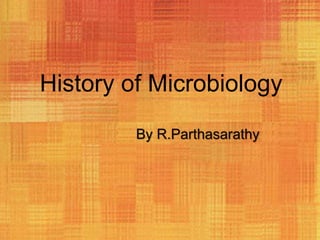
History of microbiology
- 1. History of Microbiology By R.Parthasarathy
- 2. Microbiology is the study of microorganisms / microbes which is visible only with a microscope. The diverse group of organisms includes algae, archae, bacteria, cyanobacteria, fungi, protozoa, viruses. Most of the microorganisms are harmless. 99% are good. Eg: Cynobacteria (blue green algae) 1% are bad. Eg: Pathogens MICROBIOLOGY Discovery Era Transition Era Golden Era Modern Era
- 3. DISCOVERY ERA: “Spontaneous generation” Aristotle (384-322) and others believed that living organisms could develop from non-living materials. In 13th century, Rogen Bacon described that the disease caused by a minute “seed” or “germ”. Antony Van Leeuwenhoek (1632 – 1723) Descriptions of Protozoa, basic types of bacteria, yeasts and algae. Father of Bacteriology and protozoology. In 1676, he observed and described microorganisms such as bacteria and protozoa as “Animalcules”. The term microbe is used by Sedillot in 1878.
- 4. TRANSITION ERA: Francesco Redi (1626 - 1697) He showed that maggots would not arise from decaying meat, when it is covered. John Needham (1713 – 1781) Supporter of the spontaneous generation theory. He proposed that tiny organism(animalcules) arose spontaneously on the mutton gravy. He covered the flasks with cork as done by Redi, Still the microbes appeared on mutton broth. Lazzaro spallanzai (1729 – 1799) He demonstrated that air carried germs to the culture medium. He showed that boiled broth would not give rise to microscopic forms of life.
- 5. GOLDEN ERA: Louis Pasteur He is the father of Medical Microbiology. He pointed that no growth took place in swan neck shaped tubes because dust and germs had been trapped on the walls of the curved necks but if the necks were broken off so that dust fell directly down into the flask, microbial growth commenced immediately. Pasteur in 1897 suggested that mild heating at 62.8°C (145°F) for 30 minutes rather than boiling was enough to destroy the undesirable organisms without ruining the taste of the product, the process was called Pasteurization.
- 6. He invented the processes of pasteurization, fermentation and the development of effective vaccines ( rabies and anthrax). Pasteur demonstrated diseases of silkworm was due to a protozoan parasite. Contributions of Loius pasteur: He coined the term “microbiology”, aerobic, anaerobic. He disproved the theory of spontaneous germination. He demonstrated that anthrax was caused by bacteria and also produced the vaccine for the disease. He developed live attenuated vaccine for the disease.
- 7. John Tyndall (1820 - 1893) He discovered highly resistant bacterial structure, later known as endospore. Prolonged boiling or intermittent heating was necessary to kill these spores, to make the infusion completely sterilized, a process known as Tyndallisation. Lord Joseph Lister (1827-1912) He is the father of antiseptic surgery. Lister concluded that wound infections too were due to microorganisms. He also devised a method to destroy microorganisms in the operation theatre by spraying a fine mist of carbolic acid into the air.
- 8. Robert Koch (1893-1910) He demonstrated the role of bacteria in causing disease. He perfected the technique of isolating bacteria in pure culture. Robert Koch used gelatin to prepare solid media but it was not an ideal because (i) Since gelatin is a protein, it is digested by many bacteria capable of producing a proteolytic exoenzyme gelatinase that hydrolyses the protein to amino acids. (ii) It melts when the temperature rises above 25°C.
- 10. Fanne Eilshemius Hesse (1850 - 1934) One of Koch's assistant first proposed the use of agar in culture media. It was not attacked by most bacteria. Agar is better than gelatin because of its higher melting pointing (96°c) and solidifying (40 – 45°c)points. Richard Petri (1887) He developed the Petri dish (plate), a container used for solid culture media.
- 11. Edward Jenner (1749-1823) First to prevent small pox. He discovered the technique of vaccination. Alexander Flemming He discovered the penicillin from penicillium notatum that destroy several pathogenic bacteria. Paul Erlich (1920) He discovered the treatment of syphilis by using arsenic He Studied toxins and antitoxins in quantitative terms & laid foundation of biological standardization.
- 12. IMPORTANT DISCOVERIES: Bacteria: Hansen (1874) – Leprosy bacllus Neisser (1879) – Gonococcus Ogston (1881) – Staphylococcus Loeffler (1884) – Diphtheria bacillus Roux and Yersin – Diphtheria toxin Viruses: Beijerinck (1898) - Coined the term Virus for filterable infectious agents. Pasteur developed Rabies vaccine. GoodPasteur - Cultivation of viruses on chick embryos. Charles Chamberland, one of Pasteur’s associates constructed a porcelain bacterial filter. Twort and d’Herelle - Bacteriophages. Edward Jenner - Vaccination for Smallpox.
- 13. MODERN ERA: Nobel Laureates Years Nobel laureates Contribution 1901 Von behring Dipth antitox 1902 Ronald Ross Malaria 1905 Robert koch Tb 1908 Metchnikoff Phagocytosis 1945 Flemming Penicillin 1962 Watson,Crick Structur DNA 1968 Holley,Khorana Genetic code 1997 Pruisner Prions 2002 Brenner, Hervitz Genetic regulation of organ development &cell death
- 14. “To teach is to learn” THANK YOU
